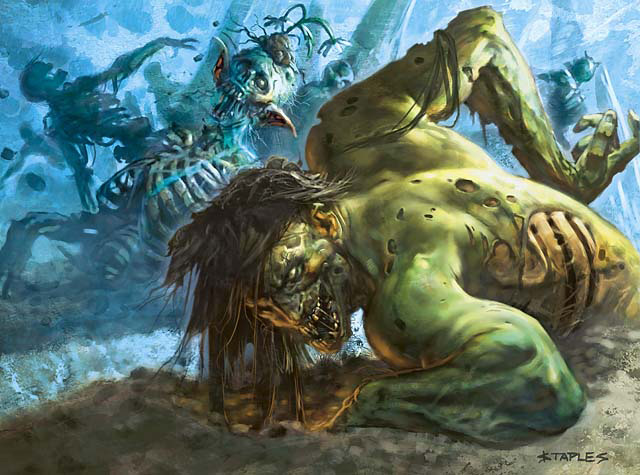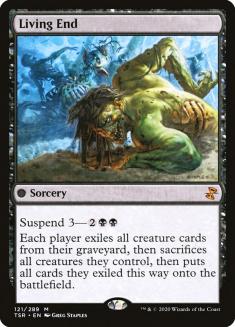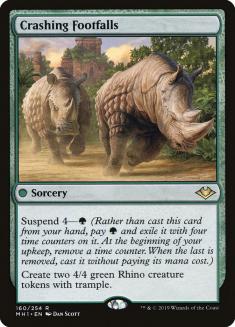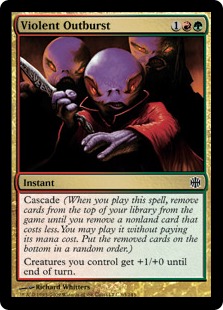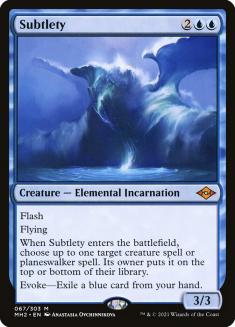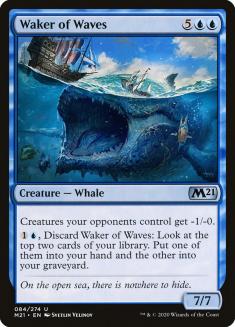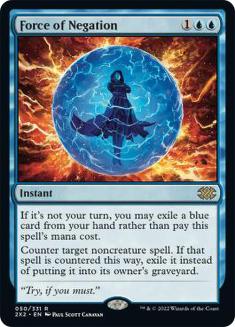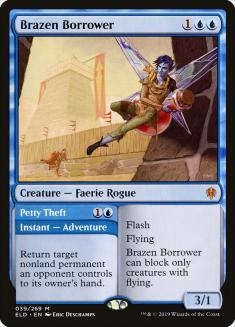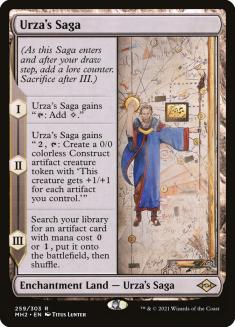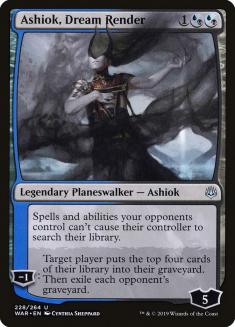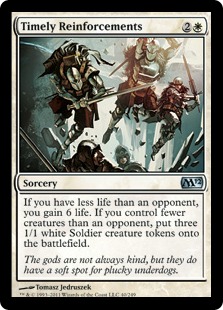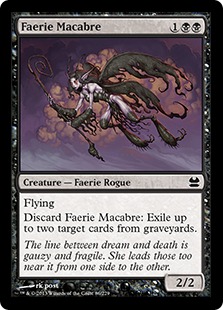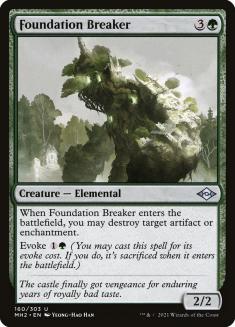Modern is full of fun and viable archetypes. Last week I covered a bunch of different builds around Dragon’s Rage Channeler (DRC), but this week I’ll cover a completely different angle.
Living End is one of the many “no cost” cards that you should be trying to cascade into. Creatures with cycling, like Curator of Mysteries or Street Wraith, fill your deck as a way to dig for a cascade card as well as fill your graveyard for Living End. Creatures like Subtlety or Grief can disrupt your opponent while adding more creatures to your graveyard, eventually reaching critical mass. Once the timing is right, all you have to do is cast one of your cascade spells, like Ardent Plea or Shardless Agent, and churn through your deck until you cast Living End for free.
Any creature-based opponent is hit by this on two metrics: losing all their creatures and having to face an army from the other side. You’re a graveyard deck, which means you may struggle against graveyard hate, but the cool part about Living End is that you still get to murk every creature on the battlefield even when your opponent has Leyline of the Void out.
A few weeks ago, I wrote about Temur Crashcade, a version of this deck that puts emphasis on cascading into Crashing Footfalls. Coupled with disruption like Fire // Ice and Force of Negation, Crashing Footfalls is a powerful spell to cascade into, as it’s relatively easy to capitalize on the pressure it applies for such a small investment. The downside is that Crashing Footfalls tends to struggle against Asmoranomardicadaistinaculdacar, and all the Food builds can generate enough Food to machine-gun down a medium-sized army.
The utility spells can also only get you so far. Making a few 4/4s is good, but is it really worth warping your whole deck around? I thought so, but losing over and over to Asmor really put me in a funk. Because of that, and the recent success of this other different Cascade deck, I decided to make the switch. Living End is the truth, so now we just need to figure out the best way to build it.
Creatures (27)
- 4 Street Wraith
- 4 Shardless Agent
- 4 Curator of Mysteries
- 4 Striped Riverwinder
- 4 Windcaller Aven
- 3 Brazen Borrower
- 2 Waker of Waves
- 2 Subtlety
Planeswalkers (2)
Lands (20)
Spells (11)

This will be the only build we’re focusing on today, though I want to make it clear that many versions do things a bit differently. Before we go over my build, I want to talk about one major choice in construction that you can go down.
Pros:
- An instant speed way to find Living End
- Occasional bursts of damage with redundant copies
Cons:
- Requires playing colors that don’t cycle your creatures
- Occasionally hard to cast if you fetch for Island
- Doesn’t pitch to Force of Negation or Subtlety
Most players are opting for Violent Outburst because it enables casting Living End on your opponent’s turn. This can be useful in a number of situations, but I’m a big fan of having redundant copies of your cascade spells be fodder for Subtlety and Force of Negation.
I’ve seen quite a few versions of Living End slanted toward Violent Outburst, but I just don’t think it’s worth it. My goal is to find a build I like that plays eight pitch spells and is flush with things it doesn’t mind exiling. Violent Outburst pushes me in entirely the opposite direction. I know that Violent Outburst is great, and the X-factor of casting Living End at instant speed can certainly save you from some hairy situations, but…
Speaking of Subtlety, I haven’t seen a lot of people playing this card in Living End and I’m not really sure why. It puts the opposing creature back into the deck instead of the graveyard, allows for free interaction in the early turns while you dig for Living End, and helps slow down a few of your potentially bad matchups.
I’ve found Subtlety to be one of the cooler cards from the new set, if only because it gets around Cavern of Souls. You haven’t lived until you’ve put Primeval Titan back on top of your opponent’s deck two turns in a row while they were using Cavern of Souls.
The secret mode of Subtlety is casting it at four mana. When you’ve turned the corner, sometimes your opponent can get back into the game if you didn’t have a lot of creatures in the graveyard before Living End. In those cases, a single Subtlety can be enough to shut the door.
Too many pitch cards can tax your resources greatly, but we have plenty of things we are willing to pitch in order to gain some leverage on the battlefield. That single turn of stalling your opponent out can make all the difference.
Teferi, Time Raveler is such a boss against some of the weird stuff that people will throw at you. Not only does it functionally change the rules of the game for your opponent, it also bounces random anti-graveyard cards after sideboard. Sending Leyline of the Void back to your Temur opponent’s hand is pretty fine, right?
One big factor when considering Teferi, Time Raveler is that you can protect yourself from cards your deck can’t normally beat. Counterspell getting reprinted has invited many blue decks back to the format. Resolving a Teferi, Time Raveler in a weird spot could be enough to put your opponent in the dirt. It’s tough for them to pressure because of bounce spells and Subtlety, and it can just replace itself in a pinch. It also completely hoses some random interactions, like an opposing cascade deck! It also bounces Urza’s Saga to your opponent’s hand, acting as a pseudo-Stone Rain when you’re on the play.
Costing two mana to put itself into the graveyard, Waker of Waves is the most expensive creature of the bunch. I think it’s fine in small amounts, as it digs a little deeper for a cascade card than your other cyclers, but it has the hidden ability of adding a second creature to your graveyard with its ability. The breaking point for Living End is often “how many creatures you’re bringing back” but you need to balance that with interaction and other game pieces. Having too many cycling creatures means you’re too one dimensional, while having too few cycling creatures means your Living End is just Wrath of God.
I’m not certain this card is better than Architects of Will or Glassdust Hulk, but it has dug me out of a few bad spots already.
The addition of Force of Negation to Modern has completely reshaped how we build cascade decks. I know this isn’t a “new” thing, but it’s one of the most important parts of any cascade build. Some metagames won’t call for the full four, but it’s just so free and bails you out of so many bad situations. I’m of the opinion that playing more pitch spells is better than playing fewer, as you don’t really use too many raw resources in a deck like this.
Finding the right balance of cyclers, cascaders, and utility / interaction is tough. Three copies of Brazen Borrower just feels right. I can’t really explain otherwise. You absolutely need it in a lot of sideboard games to help bounce Leyline of the Void, but flooding on them when you need to cast Living End or you’re short on cyclers is embarrassing. It doesn’t play defense well, and bouncing an early creature like Goblin Guide or Ragavan, Nimble Pilferer just doesn’t cut it sometimes.
Interaction cards that dodge our own cascade cards are an important part of the cascade archetype. Brazen Borrower, but mostly Petty Theft, gives us some way to tangle with our opponent in a broad way without affecting our cascade engine. It doesn’t put us down a card and only costs two mana. Maybe playing four is ultimately correct, but I’ve seen a lot of people moving down to three, and my testing has pushed me toward the same.
Guide for Sideboarding
Sideboarding will need to be a bit flexible, because our opponents will be coming at us from multiple angles. We’re vulnerable to the normal disruption like Thoughtseize or whatever, but Counterspell and anti-graveyard stuff has to be on our minds at all time. The most common forms of anti-graveyard technology will be beatable via Foundation Breaker. Surgical Extraction and Ravenous Trap see virtually no play these days, and I don’t see that changing anytime soon. Because of that, we don’t have to worry much about interaction that isn’t face up on the table.
Urza’s Saga decks will likely have some combination of hate cards that include Tormod’s Crypt, Nihil Spellbomb, and Soul-Guide Lantern. These three will come down and be able to eat your graveyard in response to killing it. Playing around these can be difficult, but not impossible. Mostly you just need to find ways to bait your opponent into popping it too early, or just force them to use it early by trying to bounce or kill it.
How you sideboard is also determined by the surrounding cast. For example. Subtlety is okay against the Dimir or Izzet versions of Food but is mediocre to bad against Golgari. That’s mostly due to the existence of Urza, but stopping Emry from coming only can make your life much easier. Recurring Soul-Guide Lantern is not great.
Instead, I’ll be going over your sideboard cards and tell you where they’re good, and what I’d bring out for them.
This is one of your best cards against anything playing Primeval Titan, but is secretly gas against a lot of decks that lightly touch the graveyard. It’s a little expensive but still great against Dredge or other all-in graveyard strategies, but the reason we’re playing it is specifically because Primeval Titan is a tough nut to crack. The combination of Subtlety and Ashiok can hopefully buy you enough time, but I’ve been clapped by nearly every Primeval Titan deck I’ve played against recently.
Force of Negation is great in these matchups because it can stop half their combo (Summoner’s Pact) or slow them down by taking Amulet of Vigor. That isn’t to say it’s great and can stop anything, but Force of Negation helps cover some bases and is almost a knockout when combined with Subtlety. Force of Negation also contains some of the sideboard cards that they might throw at you, but Urza’s Saga can put some gunk in the works.
The biggest thing to remember is that you need a high raw count of cycling creatures to actually win the game, so sideboarding those out isn’t always an option. I would recommend cutting Teferi, Time Raveler, Waker of Waves (it’s slow), and Brazen Borrower in some number when you’re bringing in sideboard cards like this. You have to think of this deck like a combo deck. Shaving on anything will start to send your deck down a weird path if you take off too much. Throughout Magic’s history, combo decks have regularly been weaker after sideboard because their core gameplan needs to be subsidized with anti-hate cards. Dredge, for example, is a deck that always has to cut something in order to get Nature’s Claim or whatever into the mix.
I’ve been majorly impressed by Timely Reinforcements, so I’m happy with the white splash if only because of this. While it doesn’t block the flyers out of Izzet Prowess, it’s great against many of the Ragavan decks and most forms of Burn. While Timely Reinforcements isn’t exactly game over, it can buy you enough time to get the ball rolling both in terms of blocking and the six points of life.
The decks where Timely Reinforcements will often be strong is where Brazen Borrower is weak. If you expect these aggro decks to bring in a ton of hate cards, cutting Teferi, Time Raveler is likely better. It usually bounces something then immediately dies to a haste creature. If Monastery Swiftspear is in your opponent’s deck, Teferi, Time Raveler shouldn’t be in yours after sideboard.
Note that if you’re boarding in Timely Reinforcements, it’s usually correct to side out Street Wraith, as your life total is a valuable resource. Drawing a Street Wraith later in the game when you’re down on life is a farce. As you play games with this deck, the sideboarding will start to come a little easier. When you realize that most of your cycling creatures have to stay, figuring out what cards to side out gets a lot easier.
A lot of Living End decks used to play Faerie Macabre in the maindeck. In some metagames, that is recommended. Right now, the top decks are all barely using the graveyard or not using them at all. Because of that, Faerie Macabre just isn’t that good, but it’s a solid sideboard card. In tandem with Ashiok, Dream Render, Faerie Macabre is a pitch way to deal with your opponent’s graveyard aggressively. It’s also solid at protecting you from your opponent taking advantage of your own Living End by discarding their hand or sacrificing their entire battlefield.
Faerie Macabre is a one-shot and doesn’t exactly win the game like some anti-graveyard measures, but it’s a creature that can be discarded and then come back. If we needed to be faster or there were a ton of Persist / Goryo’s Vengeance decks running around, maindeck Faerie Macabre would definitely be on my radar. For now, I’m more inclined to play Subtlety, though that could certainly change. Moving away from blue might also preclude a switch in creature base, making Faerie Macabre more desirable because it’s a free creature that has some utility.
This card has really impressed me. I just love spiking Urza’s Saga on the second turn. The fact that it can tag both artifacts and enchantments at two mana while dodging the cascade clause is key. It also goes to the graveyard, which is pretty cool against the low-creature count decks that are reliant on playing a mass of artifacts or enchantments. That rebuy hit on Foundation Breaker when you cast Living End can make all the difference. The first trigger on Foundation Breaker will often need to hit an opposing hate card like Rest in Peace or Grafdigger’s Cage, so the back half actually “doing the thing” can stall your opponent out.
Evoke creatures are often found in these cascade decks, and Foundation Breaker is a nice bridge so we don’t have to load up on both Ingot Chewer and Wispmare like some older builds. Since we’re already playing green for Shardless Agent, Foundation Breaker is a slam dunk. If you’re bringing in Foundation Breaker, chances are you want to be cutting some of your lackluster interaction. Teferi, Time Raveler is fine if you expect a lot of counterspells, but Brazen Borrower is pretty bad against all those Asmor decks. Bouncing creatures has little to no effect and their anti-graveyard cards will almost all be one-shot effects that exile the whole thing.
Buying Time
Time is an intersting concept in Magic. Cards that buy you time are often good against aggro or combo decks because they’re trying to end the game quickly. Slowing things down usually benefits you because you open up enough space to land more expensive spells. They thrive on casting a bunch of cheap spells and overwhelming you and your resources. Control and midrange decks require the opposite approach. You need to close the game quickly if you want to beat them because giving them more time means letting them find more of the right answers.
All your interaction in the maindeck is used to buy time or leverage an already established position. Force of Negation is a great way to shrink the time frame of the game against control or midrange because you get to stop their method of interaction or payoff. It can also buy you more time against Burn or combo by stopping their one big thing. A card like Force of Negation is powerful because it can represent multiple things against different matchups while always being free on your opponent’s turn.
When you play a deck like Living End, you put a lot of pressure on your opponent to interact with you. Graveyard checks are some of the more widely used sideboard slots because those types of decks tend to do something wild compared to normal Magic. Instead of just casting creatures, removal, discard, and counterspells, you’re making the game about a zone that most people can’t interact with in the first game. As a result, you’re heavily favored in Game 1 of most matchups, but need to be adequately prepared for an assault on your graveyard. Foundation Breaker covers most of those tools for two mana while being an absolute beating against one of Modern’s most-played cards in Urza’s Saga.
The surrounding cast to your combo are all designed to buy time or shrink the amount of time your opponent has to interact with you. The combo in question is rather easy to assemble, but requires building our deck in a very specific way. Because of that, we need to find ways to interact in the first few turns without breaking the cascade rule: all mana values need to be three or above.
One of the stranger aspects of this deck is that it’s almost like a combo deck but doesn’t always have to be. I’ve definitely gone for Living End in a pinch for just one or two creatures just because my opponent constricted my game time by applying a massive amount of pressure. All sorts of factors can force you to go for Living End when you’re not quite ready. In other games, you cycle four or five creatures in the first few turns, and then Wrath your opponent’s battlefield and put twenty power onto the battlefield.
Living End is one of the most powerful decks in the format, and also one of the more consistent. The drawback is that you’re vulnerable to both graveyard hateand counterspells. Not a lot else can interact with you favorably, which means the only other thing we have to be worried about is time. Finding ways to manage that time in your favor encompasses the rest.
Use your time wisely.

